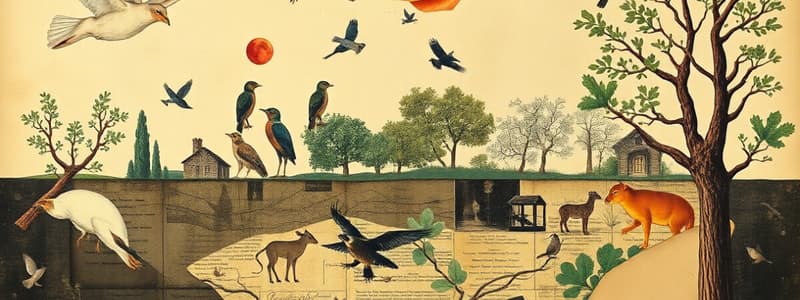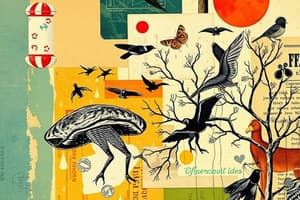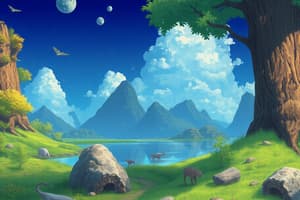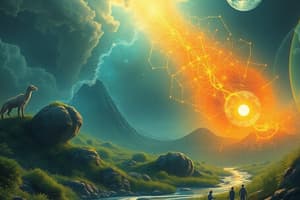Podcast
Questions and Answers
Who first proposed the term 'ecosystem'?
Who first proposed the term 'ecosystem'?
- Haeckel
- A.G. Tansley (correct)
- Charles Darwin
- Eugenius Warming
Which of the following is considered a biotic component of an ecosystem?
Which of the following is considered a biotic component of an ecosystem?
- Nutrients in soil
- Water
- Sunlight
- Microorganisms (correct)
Which group of organisms primarily synthesizes their food through photosynthesis?
Which group of organisms primarily synthesizes their food through photosynthesis?
- Decomposers
- Producers (correct)
- Herbivores
- Consumers
What does the term 'abiotic' refer to in an ecosystem?
What does the term 'abiotic' refer to in an ecosystem?
Which of the following exemplifies a non-living component of an ecosystem?
Which of the following exemplifies a non-living component of an ecosystem?
How are consumers classified in an ecosystem?
How are consumers classified in an ecosystem?
What is the primary focus of the study of ecology?
What is the primary focus of the study of ecology?
Which of the following is an example of an ecosystem?
Which of the following is an example of an ecosystem?
What is the initial step in a food chain?
What is the initial step in a food chain?
Which trophic level is represented by primary consumers?
Which trophic level is represented by primary consumers?
What percentage of energy is typically lost as heat at each trophic level?
What percentage of energy is typically lost as heat at each trophic level?
What are primary consumers also known as?
What are primary consumers also known as?
Which of the following is a characteristic of temperate grasslands?
Which of the following is a characteristic of temperate grasslands?
In which ecosystem would you most likely find a grazing food chain?
In which ecosystem would you most likely find a grazing food chain?
Which animal is a tertiary consumer?
Which animal is a tertiary consumer?
What type of food chain begins with dead organic matter?
What type of food chain begins with dead organic matter?
Which of the following statements is true regarding food webs?
Which of the following statements is true regarding food webs?
What role do decomposers play in an ecosystem?
What role do decomposers play in an ecosystem?
Which of the following is NOT a biotic component of grassland ecosystems?
Which of the following is NOT a biotic component of grassland ecosystems?
Which type of grassland is characterized by high temperatures and moderate rainfall?
Which type of grassland is characterized by high temperatures and moderate rainfall?
What type of consumers are cows and deer classified as in grassland ecosystems?
What type of consumers are cows and deer classified as in grassland ecosystems?
Secondary consumers are classified at which trophic level?
Secondary consumers are classified at which trophic level?
What role do secondary consumers play in a pond ecosystem?
What role do secondary consumers play in a pond ecosystem?
Which organisms are responsible for decomposing dead material in the ecosystem?
Which organisms are responsible for decomposing dead material in the ecosystem?
Which environmental service is NOT provided by decomposers?
Which environmental service is NOT provided by decomposers?
What characterizes the tropical desert ecosystem?
What characterizes the tropical desert ecosystem?
Which of the following is NOT a type of lake?
Which of the following is NOT a type of lake?
Which of the following abiotic components is crucial for plant growth in grasslands?
Which of the following abiotic components is crucial for plant growth in grasslands?
What impact does overgrazing have on grasslands?
What impact does overgrazing have on grasslands?
What characteristic distinguishes dystrophic lakes from other types?
What characteristic distinguishes dystrophic lakes from other types?
Which of the following animals would most likely be found in polar grasslands?
Which of the following animals would most likely be found in polar grasslands?
Which zone of the lake is described as the bottom layer?
Which zone of the lake is described as the bottom layer?
Which desert is classified as a cold desert?
Which desert is classified as a cold desert?
Which type of organisms are primary consumers in a lake ecosystem?
Which type of organisms are primary consumers in a lake ecosystem?
What is a significant reason for the importance of grasslands?
What is a significant reason for the importance of grasslands?
How much annual rainfall characterizes a desert ecosystem?
How much annual rainfall characterizes a desert ecosystem?
What is one of the ways pond ecosystems benefit animals?
What is one of the ways pond ecosystems benefit animals?
Which statement about lake ecosystems is true?
Which statement about lake ecosystems is true?
Which type of desert is characterized by very hot summers and very cold winters?
Which type of desert is characterized by very hot summers and very cold winters?
What aspect defines the biodiversity within pond ecosystems?
What aspect defines the biodiversity within pond ecosystems?
What is the primary role of secondary consumers in an ecosystem?
What is the primary role of secondary consumers in an ecosystem?
Which abiotic component is most directly responsible for the oxygenation of running water in rivers and streams?
Which abiotic component is most directly responsible for the oxygenation of running water in rivers and streams?
In an ocean ecosystem, which zone is known for high primary productivity due to abundant sunlight and nutrients?
In an ocean ecosystem, which zone is known for high primary productivity due to abundant sunlight and nutrients?
What key characteristic distinguishes the abyssal zone of the ocean?
What key characteristic distinguishes the abyssal zone of the ocean?
Which organisms are primarily considered producers in a river or stream ecosystem?
Which organisms are primarily considered producers in a river or stream ecosystem?
Which of the following is NOT a characteristic of ocean ecosystems?
Which of the following is NOT a characteristic of ocean ecosystems?
What is the role of decomposers in both river and ocean ecosystems?
What is the role of decomposers in both river and ocean ecosystems?
Which factor contributes to the nutrient-rich environment in the coastal zone of oceans?
Which factor contributes to the nutrient-rich environment in the coastal zone of oceans?
Flashcards
Ecology Definition
Ecology Definition
Ecology is the study of interactions among organisms and their environment.
Ecosystem Definition
Ecosystem Definition
An ecosystem is a community of organisms interacting with each other and their environment, exchanging energy and matter.
Ecosystem Components
Ecosystem Components
Ecosystems consist of biotic (living) components and abiotic (non-living) components.
Food Chain
Food Chain
Signup and view all the flashcards
Biotic Components (examples)
Biotic Components (examples)
Signup and view all the flashcards
Abiotic Components (examples)
Abiotic Components (examples)
Signup and view all the flashcards
Tropic Level
Tropic Level
Signup and view all the flashcards
Producers (Autotrophs)
Producers (Autotrophs)
Signup and view all the flashcards
Grazing Food Chain
Grazing Food Chain
Signup and view all the flashcards
Detritus Food Chain
Detritus Food Chain
Signup and view all the flashcards
Consumers
Consumers
Signup and view all the flashcards
Decomposers
Decomposers
Signup and view all the flashcards
Food Web
Food Web
Signup and view all the flashcards
Producer
Producer
Signup and view all the flashcards
Herbivore
Herbivore
Signup and view all the flashcards
Decomposer
Decomposer
Signup and view all the flashcards
Primary Consumers
Primary Consumers
Signup and view all the flashcards
Secondary Consumers
Secondary Consumers
Signup and view all the flashcards
Tertiary Consumers
Tertiary Consumers
Signup and view all the flashcards
Tropical Grassland (Savanna)
Tropical Grassland (Savanna)
Signup and view all the flashcards
Temperate Grassland
Temperate Grassland
Signup and view all the flashcards
Polar Grassland
Polar Grassland
Signup and view all the flashcards
Overgrazing
Overgrazing
Signup and view all the flashcards
Secondary Consumer (Carnivore)
Secondary Consumer (Carnivore)
Signup and view all the flashcards
Oligotrophic Lake
Oligotrophic Lake
Signup and view all the flashcards
Eutrophic Lake
Eutrophic Lake
Signup and view all the flashcards
Primary Consumer (Zooplankton)
Primary Consumer (Zooplankton)
Signup and view all the flashcards
Producer (Pond Ecosystem)
Producer (Pond Ecosystem)
Signup and view all the flashcards
Littoral Zone (Lake)
Littoral Zone (Lake)
Signup and view all the flashcards
Grassland Ecosystem Abiotic Components
Grassland Ecosystem Abiotic Components
Signup and view all the flashcards
Grassland Ecosystem Producers
Grassland Ecosystem Producers
Signup and view all the flashcards
Desert Ecosystem Rainfall
Desert Ecosystem Rainfall
Signup and view all the flashcards
Desert Ecosystem Characteristics
Desert Ecosystem Characteristics
Signup and view all the flashcards
Desert Ecosystem Abiotic Components (2)
Desert Ecosystem Abiotic Components (2)
Signup and view all the flashcards
Tropical Desert
Tropical Desert
Signup and view all the flashcards
Grassland Ecosystem Primary Consumers
Grassland Ecosystem Primary Consumers
Signup and view all the flashcards
Grassland Ecosystem Importance
Grassland Ecosystem Importance
Signup and view all the flashcards
Primary Consumers (Aquatic)
Primary Consumers (Aquatic)
Signup and view all the flashcards
Secondary Consumers (Aquatic)
Secondary Consumers (Aquatic)
Signup and view all the flashcards
Tertiary Consumers (Aquatic)
Tertiary Consumers (Aquatic)
Signup and view all the flashcards
Decomposers (Aquatic)
Decomposers (Aquatic)
Signup and view all the flashcards
Coastal Zone (Ocean)
Coastal Zone (Ocean)
Signup and view all the flashcards
Euphotic Zone (Ocean)
Euphotic Zone (Ocean)
Signup and view all the flashcards
River/Stream Ecosystem
River/Stream Ecosystem
Signup and view all the flashcards
Abiotic Components (Ecosystem)
Abiotic Components (Ecosystem)
Signup and view all the flashcards
Study Notes
Ecology - Ecosystem
- Ecology is the study of interactions between organisms and their environment.
- German biologist Ernst Haeckel coined the term "ecology" in 1869.
- The word ecology comes from Greek words: 'oikos' meaning "house" or "habitat" and 'logos' meaning "study."
- Danish botanist Eugenius Warming further elaborated on the concept of ecology.
- An ecosystem includes both biotic (living) and abiotic (non-living) components.
- The abiotic components of an ecosystem include sunlight, water, wind, nutrients, and heat.
- The biotic components include plants, animals, and microorganisms.
- The term "ecosystem" was first proposed by A.G. Tansley in 1935.
- Ecosystems include a wide range of examples such as ponds, deserts, forests, estuaries, and oceans.
Definition of Ecosystem
- An ecosystem is a community of different species that interact with one another and their non-living environment; exchanging energy and matter.
- Ecology is the study of systems, including ecosystems.
- Animals cannot synthesize their food directly and depend on plants for sustenance either directly or indirectly.
Non-living Components of an Ecosystem
- Light
- Water
- Wind
- Nutrients in soil
- Heat
- Solar radiation
- Atmosphere
Living Components of an Ecosystem
- Plants
- Animals
- Microorganisms in soil
Structure of an Ecosystem
- Ecosystems consist of two major components: biotic (living) and abiotic (non-living).
- Biotic components include all living organisms in the ecosystem, often collectively called the biotic community. Examples: Plants, Animals, Microorganisms
- Abiotic components include all non-living physical and chemical elements. Examples: Climate, Soil, Water, Air, Energy
Classification of Biotic Components
- Producers (Autotrophs): Plants synthesize their food through photosynthesis. Examples: All green plants, trees, algae.
- Consumers (Heterotrophs): Animals depend on other organisms for food.
- Primary consumers (herbivores) eat plants. Example: Insects, rats, deer, cows.
- Secondary consumers (primary carnivores) eat primary consumers. Example: Frogs, cats, snakes, small birds.
- Tertiary consumers (secondary carnivores) eat secondary consumers. Example: Hawk, eagle, tiger, lion.
- Decomposers (saprotrophs/detritivores): Break down dead organisms and return nutrients. Example: Fungi, Bacteria
Producers (Autotrophs)
- Producers make their own food, often through photosynthesis.
- Example: All green plants, trees use chlorophyll, CO2 and H2O, with sunlight to make carbohydrates (starch). Equation 6CO2 + 6H2O → C6H12O6 + 6O2
Consumers
- Herbivores: Eat plants, like squirrels and rabbits.
- Carnivores: Eat animals, like snakes and hawks.
- Omnivores: Eat both plants and animals. Example: Humans, rats, birds.
- Detritivores: Feed on dead organic material. Example: Termites, earthworms.
Decomposers
- Break down dead organisms and return nutrients to the soil.
- Examples: Fungi, bacteria
Abiotic Components
- These are nonliving things in an ecosystem.
- Physical components include energy, climate, nutrients, and living space
- Chemical components such as organic substances (protein, lipids, carbohydrates) and inorganic substances (minerals).
Types of Ecosystems
- Natural ecosystems are those that operate under natural conditions. They are further divided into terrestrial and aquatic:
- Terrestrial: These ecosystems are related to land. Example: Grasslands, forest, deserts.
- Aquatic: These ecosystems are related to water. They are further subdivided by the salinity of the water:
- Freshwater: Example: Ponds, rivers, streams, lakes.
- Marine: Example: Seas, oceans, estuaries.
- Artificial Ecosystems: These are maintained by humans. Example: Croplands, gardens.
Function of an Ecosystem
- Allow flow of energy and cycling of nutrients.
- Primary function: manufacture of carbohydrates/starch via photosynthesis by producers..
- Secondary function: Distribute energy in the form of food to all consumers.
- Tertiary function: Decomposition of dead organisms returns nutrients to soil; maintaining the nutrient cycle.
Energy Flow
- Solar energy is the primary energy source for most ecosystems.
- Plants (producers) transform solar energy into chemical energy through photosynthesis.
- Chemical energy is passed along food chains to consumers.
- There is a loss of energy at each trophic level (feeding level) as heat.
Food Chains
- A food chain is a sequence of eating and being eaten in an ecosystem.
- It represents the flow of energy from producers to consumers.
- Organisms die and are decomposed by microorganisms, releasing nutrients back into the soil, supporting plant growth.
- Energy is lost as heat.
Food Webs
- Interlocking pattern of various food chains in an ecosystem.
- It shows a complex feeding network where organisms can be eaten by several other organisms at various tropic levels.
Ecological Pyramids
- Graphical representation of trophic levels which show the arrangement of organisms according to their feeding relationships.
- Pyramid of Numbers: Shows the numbers of organisms at each trophic level, often looking like an upside-down triangle in an inverted ecosystem (tree parasitism).
- Pyramid of Biomass: Shows the relative mass of organisms at each trophic level, frequently upright for most ecosystems.
- Pyramid of Energy: Shows the amounts of energy available at each trophic level.
Important Considerations of Food Chains/Webs and Ecological Pyramids
- The amount of potential energy available for the next tropic level decreases drastically (approximately 90%).
- The loss of energy is primarily in the form of metabolic heat.
- Food chains and food webs are useful for depicting transfer of energy as well as how populations of different species interact.
Types of Aquatic Zones
- Freshwater life zones include ponds, streams, lakes, and rivers.
- Saltwater life zones include oceans and estuaries.
Importance of Ecosystems
- Maintaining biodiversity.
- Providing habitats for a variety of organisms.
- Regulating climate/weather.
Studying That Suits You
Use AI to generate personalized quizzes and flashcards to suit your learning preferences.




